Tree Blindness? Just Open Your Eyes!
Recently in my backyard, I have noticed much more than finely cut grass and small patches of dandelions. I have found what some may call botanical beasts – trees! It has been brought to my attention that I have been tree blind and do not know my trees as well as I should – and tackling the tasks of identifying these beasts has proven to be more difficult than expected! But not a challenge I am not willing to tackle!
In Gabriel Popkin’s article in the NY Times, “Tree Blindness” he describes a condition I was definitely unaware of and suffering from! How could I have possibly ignored these giants before with my own tree blindness? But now I am working on the “cure” and trying to pay more attention. In the article, Popkin discusses how identifying trees can not only be a way to show off to your friends but also to “pay attention”. I really appreciate that take because if we do not pay attention or notice the beauties that are around us, we will not only miss out on the joys they can give us but also fail to recognize their importance. By using your guide and just taking a peek at some nature outside your door – you’re one step closer to understanding the gigantic impact they have on this world. And with this adventure, I hope to do just that!
I started my journey of discovery at the Spring Valley Nature Preserve in Granville, Ohio. The environment was a woody forest with an occasional stream nearby.
-
Blue Ash – Fraxinus quagrangulata
We started with this first specimen with curiosity noticing its opposite leaf arrangement with pinnately compound leaflets. This pointed me toward the Ash genus but at first, I was unsure of the species. It was found right off of the path in a woody and high area.
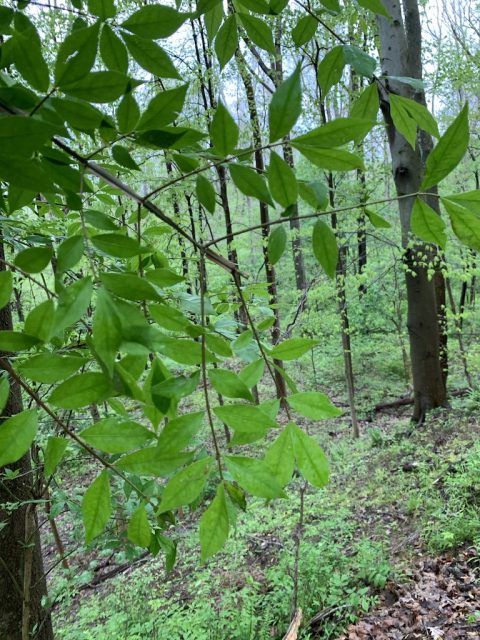
Opposite, pinnately compound leaves of a mystery Ash
Until… the leaves were finely toothed and most peculiarly – its twigs had a box-like layer to them. So it must be a Blue Ash! One thing special to this species got its name from the blue dye that can come from the inner bark that pioneers would use for textiles. (https://www.hobbyfarms.com/4-things-you-didnt-know-about-the-blue-ash/)
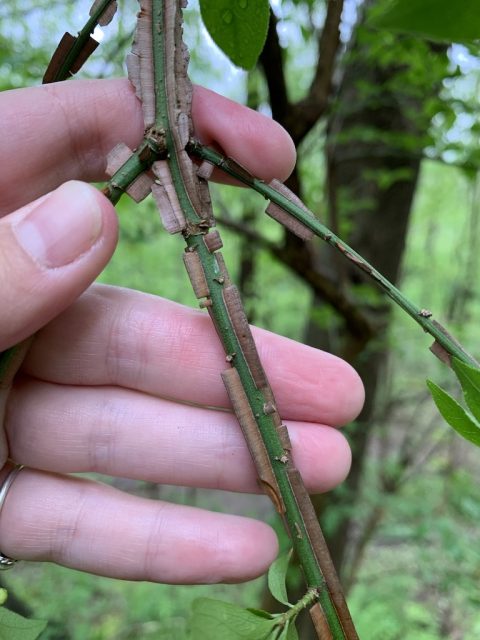
Box/squared twigs mean Blue Ash!
Tulip Tree – Liriodendron tulipifera
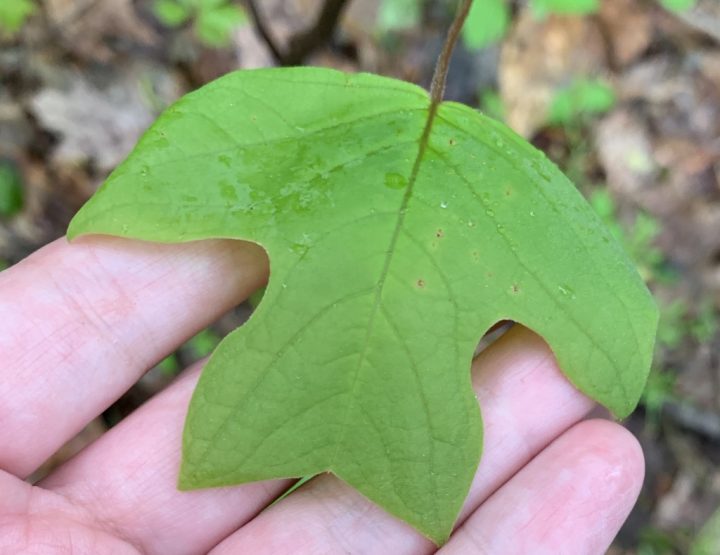
Lobed leaf of a Tulip tree
Peculiarity seemed to be a theme in this part of the woods because this next tree caught my eye with its fun shaped leaves. It had alternate leaf arrangement and simple complexity. The lobed leaf shape gave away its identity as a Tulip Tree! This specimen was found to in a lower woody part of the preserve. These trees are one of the largest in our area and have a wide trunk diameter, second only to the sycamore, and grow up to 90 feet! (https://www.mortonarb.org/trees-plants/tree-plant-descriptions/tuliptree)
Ohio Buckeye – Aesculus glabra
Next comes a hometown favorite! I knew its genus from its opposite, palmately compound leaves – must be a Buckeye….but which one you ask??? Well, we can narrow it down to either a sweet or Ohio Buckeye due to its five leaflets. So I snapped a twig and took a sniff and PEE YEW! The skunky smell leads us to the Ohio Buckeye. ..Why does the Ohio species have to be the stinky one! This special one was found on similar grounds as the tulip tree – low and woody area.
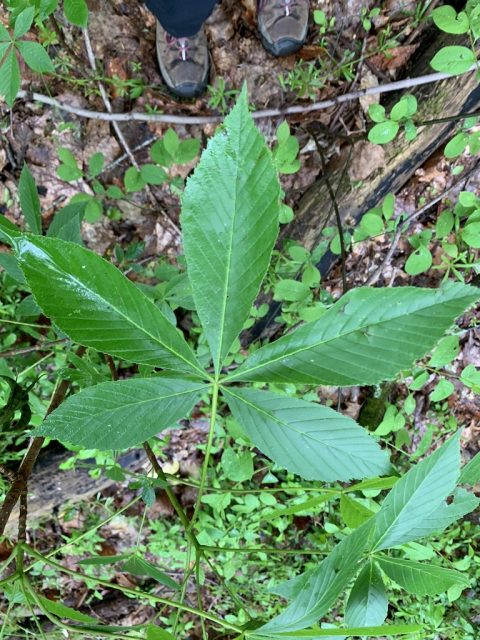
Palmately compound buckeye leaves with a stinky secret!
Buckeyes are often referred to as nuts but in actuality, they are nut-like seeds. So we may all be nuts – but not because we are buckeyes… Native Americans would often use and boil these toxic buckeyes to use as a health aid but nowadays we use them to make necklaces and keep some good luck! (https://www.arborday.org/programs/nationaltree/buckeye.cfm)
Redbud – Cercis canadensis
Our next victim was also a dead giveaway. Blooming in gorgeous pinkish-purple flowers with heart-shaped alternate simple leaves this beauty was a redbud and proud of it! Naively I had assumed these purple trees were dogwoods but pink dogwoods have a more bubblegum color than the fuscia-like color in a Redbud.. rookie mistake! This Redbud was found near a stream in the nature preserve but on the edge of the woods.
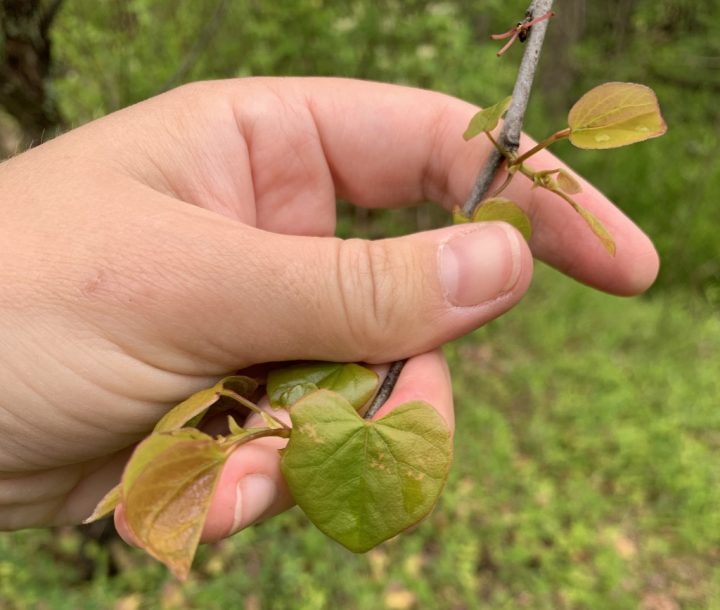
Heart-shaped leaves = cuteness overload
Redbuds can produce flowers right off of their trunk – this is known as cauliflory. And not only are they a fantastic sight but the flowers and buds are edible. Perfect for a mid-adventure snack! (https://www.softschools.com/facts/plants/redbud_tree_facts/679/)
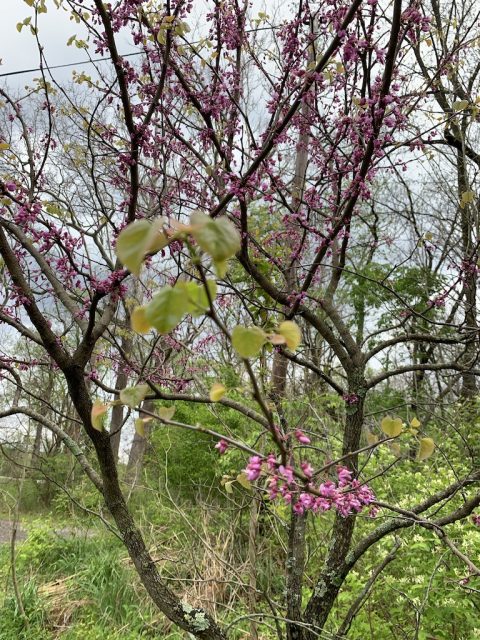
inadequate representation of her purple-pink majesty
Sugar Maple – Acer saccharum
For this beast with oppositely arranged leaves and a simple and conspicuously lobed leaf shape – I knew it had to be a Maple! But which one can be kind of sticky (haha get it? sticky like maple syrup!). The lobes were prominent and the underside of the leaf was green not silver. It had to be a sugar maple! This maple was found near the stream as well but a little further into the woods.

Prominently lobed simple leaves of Sugar Maple
Sugar Maples are highly valued and loved trees due to their wood and sap to make maple syrup of course! Their hardwood can also be used for building furniture and other goodies. An arboretum in my home town will have days in the spring where you can learn how to tap into the trees to get natural syrup and it is big fun! (but if I am being honest natural maple syrup doesn`t have enough sugar for me!) (https://ostermiller.org/tree/sugarmaple.html)
Common Cottonwood- Populus deltoides
This tree stumped me (haha) at first because of its alternate arrangement and simple complexity. Until I realized its leaf shape was peculiar. It had coarsely toothed leaves with a flat bottom and a yellow-ish color to the twigs….hmm its a common cottonwood!! The Cottonwood was also by the stream but found very close to the water – note the sand/mud beach below.
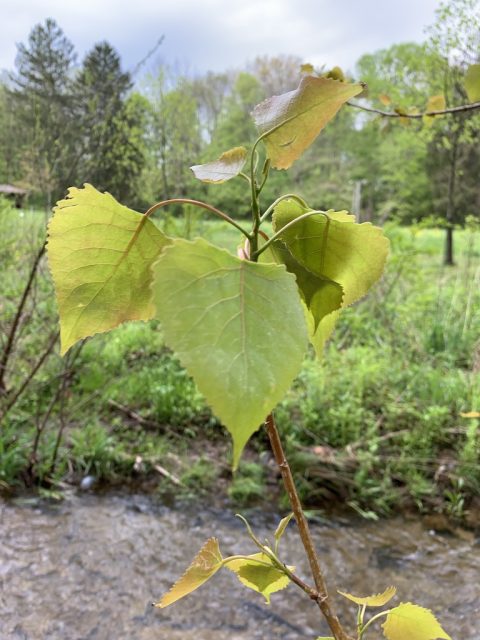
Flat bottom leaves with yellowish twigs
Cottonwoods were very useful to Native Americans. They would hollow out the trunks and use them as canoes as well as used the sprouts and inner bark as a food source for both humans and animals. ( https://www.gardeningknowhow.com/ornamental/trees/cottonwood/cottonwood-tree-in-landscapes.htm)
Now we head to a lot behind my neighbor’s yard that is not developed – it has lots of large trees, shrubs, and natural babies that had not been kept/cultivated. The setting was a woody forest without any stream or river nearby. Many of the trees were very large and too high for me to reach but we got a couple!
American Elm – Ulmus americana
I had seen similar leaves like this one at the first site I went to but wasn’t entirely confident in what it was…I just noticed the crimped pattern on the leaf.. it looks like it’s in the 90s! It was found on high ground woods with an open area.
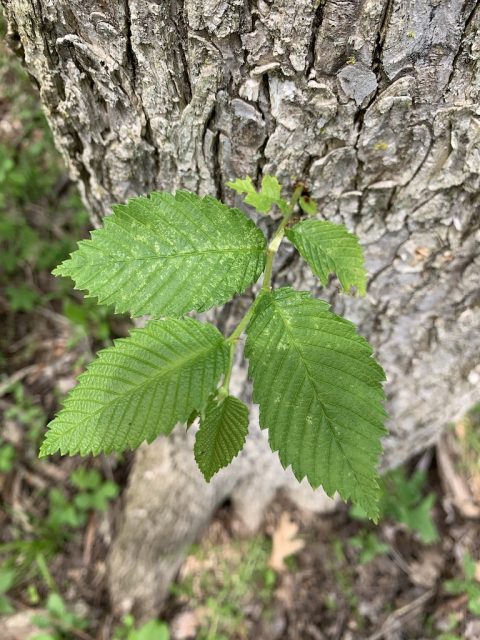
Toothed edge and feathered veins in the leaves
It had an alternate arrangement with simple complexity and a toothed edge which led me to the Elms! But which one could it be!
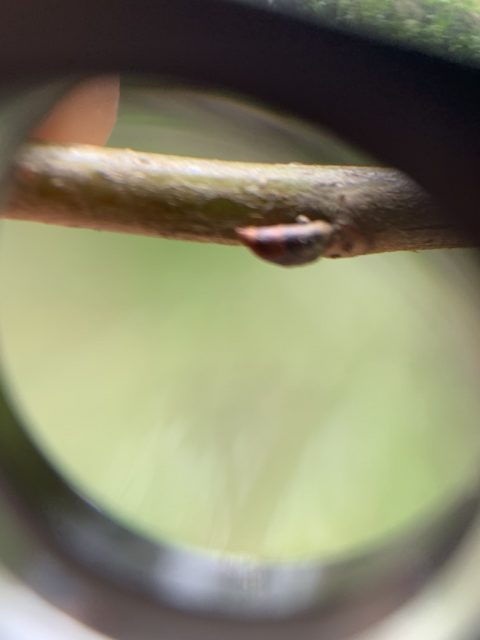
Poor quality picture of the red/brown bud thru my handy dandy hand lens
Looking closer at the buds, I found them to be red/brown and hairless. The elm also lacked “wings” that often arise in some species. The leaves had a sandpapery top but hairless underneath. So with these clues, it must be the American Elm! This elm can grow to be very tall (80 ft) and if space allows, the trunk will split and form a vase shape. This elm was also victim to Dutch Elm disease, an Asian fungus, which cuts the normal lifespan of 200 years to around only 30. Conservation efforts are underway trying to solve this problem and help the species! (http://www.museum.state.il.us/muslink/forest/htmls/trees/U-americana.html)
Fire Cherry – Prunus pensylvanica
This tree was also tricky due to its alternate simple leaves. I noted it had finely toothed leaves and its shape was oblong but narrow at the tip – this leads me to either a Black Cherry or a Fire cherry. However, the leaves were hairless on both sides and its bark had some horizontal notches meaning its a Fire Cherry! The cherry was also on higher ground in this wooded area.
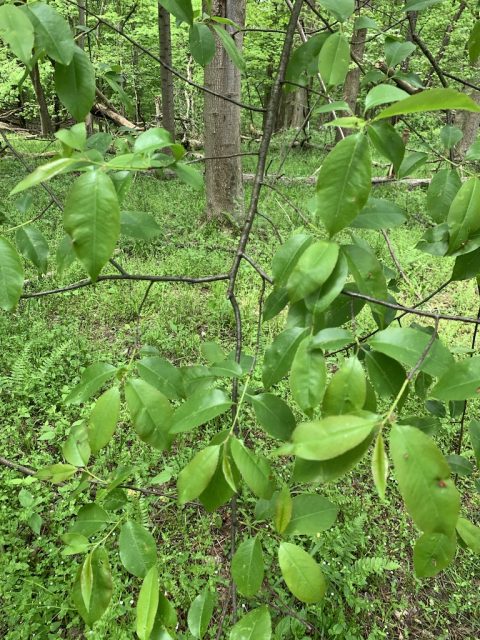
Branch of Fire Cherry with trunk in the background – notice horizontal notches
I couldn’t get great pictures of the branches because most were high up. But I managed to snag one branch for a quick photo shoot.
Something fun about this species is its meaning behind its name! The seeds of the fire cherry are fire resistant and can survive forest fires leading them to propagate after the fire! That seems like a useful trait to me! Its flowers can be beautiful and white and bloom in April! (http://www.tree-guide.com/fire-cherry)
Tree blindness can be easily cured and replaced with an open mind and willingness to learn. It is a challenge and task that takes some getting used to but also one that doesn’t require perfection. The dendro-licious babies deserve so much love and way more than we are giving them! Maybe the cure for tree blindness isn’t a cure at all – its just opening your eyes. 🌳
